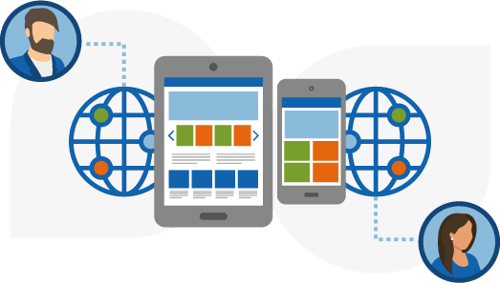With careful design and implementation, peer-to-peer e-learning provides an effective lifeline for organisations adapting to entirely new ways of working.
Peer-to-peer learning strengthens how knowledge flows throughout organisations by encouraging collaboration, open communication, and collective learning opportunities. Through features such as peer instruction, mentoring programs, team-based projects, and collaborative assessment, organisations create an engaging environment where employees can tap into each other's skills and unique viewpoints.
This method doesn't just help people remember what they've learned better - it also increases employee motivation, builds stronger team relationships, and nurtures a workplace culture where everyone is committed to ongoing development and growth.
TL;DR: Key features of peer-to-peer collaborative learning for sharing knowledge
- Peer instruction: enabling learners to engage in short discussions to more firmly embed a concept
- Peer mentoring: where more experienced employees support and guide their less experienced colleagues to facilitate knownledge transfer
- Collaborative projects: working together allows your teams to share knowledge, learn from each other and develop new skills
- Peer assessment: feedback from peers helps individuals identify areas for improvement and to understand that others may have different perspectives on their work
- Promoting a culture of openness: collaborative spaces foster a safe space to ask questions, share ideas and seek help
- Breaking down of silos: peer-to-peer learning encourages collaboration across different teams, departments, countries
- Enhancing employee engagement: employees feel more connected to their work and become more invested in the organisation's success
- Facilitate remote learning: peer-to-peer learning can be effective for remote employees and teams, overcoming feelings of isolation
Driving e-learning collaboration
Seemingly overnight, COVID-19 triggered a radical reworking of work. Digital transformation plans accelerated from months to days, as companies scrambled to move customer-facing operations online, reconfigure supply chains, set their people up to work from home and create new processes and practices for remote collaborative working.
Navigating this shift has been a source of pride for many companies – and now is a great time to raise the bar and focus on building those e-learning capabilities that will serve their strategies in the post-pandemic future. Traditional training and leadership-building programs are no longer sufficient.
As everyone embraces today’s virtual world to better connect, e-learning’s collaborative experiences are growing in popularity - and offer huge potential for a new way of learning and working. In this article, we'll explore some of the benefits of collaborative learning and how you could achieve these with the right e-learning platform.
What is collaborative e-learning?
Collaborative e-learning is the seamless integration of social interactions with online peers, instructors, and experts. Online learners have the opportunity to see things from a number of different perspectives while still being able to problem-solve in group settings.
As a result, everyone gets what they need from the collaborative learning experience. They also have the ability to independently develop and share their skills and knowledge for the improvement of others, creating an even stronger corporate learning culture.

Collaborative e-learning platforms allow the creation of digital workspaces, enabling teams to work together to problem solve and learn. These workspaces are powerful, virtual areas where users can put the collaborative learning theory into practice by engaging in social and continuous learning can flourish, informal brainstorming sessions can happen precisely when you require support, and individuals can compile any number of resources that they feel make their job easier.
Benefits of collaborative e-learning
Peer-driven learning
Your employees are your greatest competitive resource with their talent, expertise, and skills integral to the success of the organisation. A collaborative e-learning platform lets you harness and amplify that resource by giving them the opportunity to teach and learn from one another.
Online learners can upload their assignments, write blog posts, create and share their own content and add ideas to a group messaging board. In return, they receive valuable input from their online peers, enabling them to identify areas for improvement, bridge performance gaps and get exposed to others’ content to expand their learning environment.

As an L&D manager, collaborative e-learning platforms will ensure that you get the most mileage from all your employee’s skills and talents. Your content will be more company-and team-specific than generic purchased content. It’s a great way to knock down information silos and spread the knowledge wealth around.
In addition to being a benefit to your bottom line, collaborative learning brings many psychological and scientific benefits such as increasing knowledge retention, better employee engagement, and enhanced workplace communication. In short, you're building a stronger, smarter, more engaged team
Improves online learner engagement
For adults, learning by doing beats learning by listening alone. Studies have shown that adults can recall nearly seven times more content by doing, particularly when those exercises are held in an environment where people are able to make mistakes without consequences. And this is one of the key advantages of an LMS with a strong collaborative platform.
Moreover, because we like social interaction, relying on social groups to communicate and share our experiences, collaborative e-learning improves engagement and participation, as it appeals to this social need. Online learners are therefore able to explore new ideas and concepts with their peers from around the world, without venturing into a public forum.
For example, web-based video conferencing applications, with screen-sharing, whiteboards for collaborating, annotation functions, group chat, and breakout rooms enables people to carry out realistic learn-by-doing tasks in group settings that heighten engagement and reinforce skill retention.

The creative use of learning management system (LMS) technology and careful course design can go a long way toward fostering a social, collaborative experience remotely. This virtual environment can also gives those employees who are less comfortable with public speaking or group activities a greater opportunity to participate. through the mix of session formats and the many tools that enable discussion, exercises.
By encouraging lively interaction during training, companies can foster strong remote communities that continue past the training program.
Fosters a sense of online learning community
In today’s remote-working environment, there is always the fear that online learners may feel overly isolated, primarily because they aren’t in the same physical space as their peers or online instructors.
Collaborative e-learning helps you build an online learning community where virtual learners get the support they need. But these communities don’t just suddenly appear and L&D managers need to create the necessary groundwork by encouraging forums, social groups, teams and e-learning blogs in order to facilitate the process. Online learners may need encouragement to share their thoughts, given opportunities to introduce themselves and meet like-minded individuals.

The LMS solution should enable your employees to easily compile a list of online resources that that they find useful, either for their own purposes or to share amongst their peers.
Decentralising the learning process
Unlike the traditional top-down approach to learning, a good LMS and collaborative e-learning platform will facilitate a bottom-up process where everyone can contribute to building learning content and a strong e-learning environment. Instead of pushing knowledge on employees, as in the the usual top-down approach, companies committed to collaborative e-learning actively encourage their employees to be part of the learning process, contributing their own specialist knowledge to a bottom-up approach to learning.
This democratised approach reduces knowledge silos and opens up information to everyone throughout the organisation. This degree of individual interaction and buy-in actively encourages learners to be more active in their personal learning process and will result in much more meaningful outcomes for both learner and the organisation.
Golden age of LMS learning
The question is: How do companies accomplish this? Can they achieve anywhere near the levels of trust, bonding, and team-building that are possible with in-person, hands-on experiential programs?
The short answer is – absolutely. But in order to accomplish this, businesses need the right tools, particularly a powerful LMS and learning experience platform (LXP) that has collaborative e-learning theory at its core.
Totara Engage
With Totara Engage, you can boost learning programs and harness the power of informal learning and collaboration. Totara Engage removes the limits of formal learning and embraces the power of the collective to create and curate more learning content than ever before.
Some of the key features the Totara Engage include:
-
Users are able to set up a range of different workspaces types depending on their needs:
-
Public workspaces mean anyone can view and join the workspace.
-
Private workspaces allow teams to work together on projects or can be set up for a group of users to learn together. Users will need to request access by a workspace owner in order to join a private workspace.
-
Hidden workspaces cannot be found by users in the system. Workspace owners have to invite members to join a hidden workspace. These can be useful for small teams or to work to deliver a collaborative learning project.
-
-
Collaborate with ease
Users can post discussion topics and tag anyone in the organisation. Users are also able to like comments and recognise their colleagues for contributions to a workspace
-
Upload and share resources
Users can upload any content that they deem useful to help them succeed in their goals. Users can add resources such as internal documents and external resources such as reports, videos or podcasts directly to the workspace. Anything that can help the team to develop or meet a goal can be added to a workspace.
-
Personalised notifications
Users are able to define what and how they are notified on actions happening in a workspace. Users can change the settings to ensure that they only receive the notifications that matter most to them to create a truly personalised experience for each user in the system.
-
Report on employee engagement
Site administrators can report on the levels of employee engagement in each workspace and, at a glance, see which workspaces are the most popular and which have the most resources. You’ll be able to have an overview and see where your people need more support or where your employee engagement efforts are working particularly well.
Meeting the e-learning needs of today’s organisations
Learning will continue be the foundation of your business’s survival - and for the individuals who make up your organisation. As the world shifts to online work and businesses struggle to reinvent themselves, organisations need to learn what kinds of new products and services will appeal to their consumers and learn how to create them. Leaders must learn how to keep a distributed workforce focused, energised, and attuned to customers’ changing needs.
Collaboration is a crucial skill that needs to be encouraged and evolved to meet the demands of today’s post pandemic business world, where human contacts may be more limited. Businesses need to establish a strong collaborative e-learning culture and adopt the tools and equip their employees with the resources and skills to face this new world of working together.
If you’d like to learn more about how to set up an effective e-learning platform for your organisation, talk to a Hubken e-learning specialist today.
Frequently Asked Questions
What is collaborative e-learning and how does it work?
Collaborative e-learning is the seamless integration of social interactions with online peers, instructors, and experts through digital learning platforms.
It enables learners to see multiple perspectives while problem-solving in group settings through features like peer-to-peer instruction, collaborative projects, peer mentoring, and peer-to-peer assessment.
Online learners can upload assignments, write blog posts, create and share content, and contribute to group messaging boards, receiving valuable input from their peers to identify improvement areas and bridge performance gaps.
This approach transforms traditional top-down learning into a democratized, bottom-up process where everyone contributes to sharing knowledge.
How does collaborative e-learning improve employee engagement?
Collaborative e-learning significantly boosts engagement because adults learn better by doing rather than just listening - studies show people can recall nearly seven times more content through active participation.
Because we like social interaction and rely on social groups to communicate and share experiences, collaborative e-learning improves engagement by appealing to this social need. Features like web-based video conferencing with screen-sharing, whiteboards, annotation functions, and breakout rooms enable realistic learn-by-doing tasks that heighten engagement and reinforce skill retention.
This approach also gives employees who are less comfortable with public speaking greater opportunities to participate through various session formats and discussion tools.
What are the key benefits of peer-to-peer learning in organisations?
Peer-to-peer learning harnesses employees as your greatest competitive resource by enabling them to teach and learn from one another.
Key benefits include breaking down information silos, spreading knowledge throughout the organisation, increasing knowledge retention, improving employee engagement, enhancing workplace communication, and building stronger team relationships.
It also facilitates remote learning effectiveness, helping overcome feelings of isolation while promoting a culture of openness where employees feel safe to ask questions, share ideas, and seek help across different teams and departments.
How can organisations implement collaborative e-learning effectively?
Effective collaborative e-learning implementation requires the right LMS platform with collaborative features at its core. Totara Learn exemplifies this with collaborative working features built into it's native functionality. These include:
- different workspace types: public workspaces for open collaboration, private workspaces for team projects, and hidden workspaces for small groups.
- Users can post discussion topics, tag colleagues, upload and share resources like internal documents and external content, and receive personalized notifications.
Organisations should encourage forums, social groups, and e-learning blogs while providing reporting capabilities to track employee engagement levels and identify where additional support is needed.
Success requires creating the necessary groundwork and encouraging employees to actively participate in the collaborative learning process.

Book a free LXP demo
Learn first-hand how an LXP from Hubken could enhance your L&D strategy with powerful collaborative learning functionality
.png?width=1080&height=520&name=Blog%20CTAs%20(17).png)



